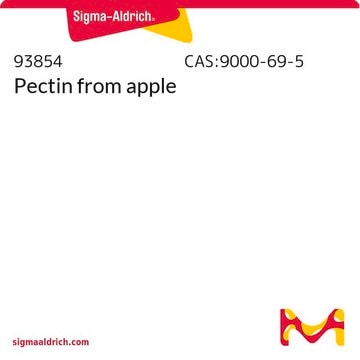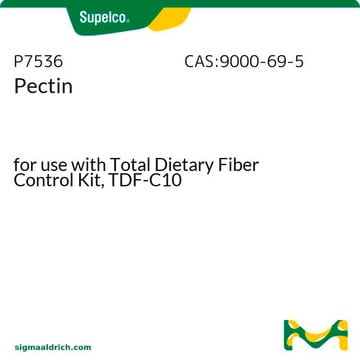P9135
Pectin from citrus peel
Galacturonic acid ≥74.0 % (dried basis)
Synonyme(s) :
Poly-D-galacturonic acid methyl ester
About This Item
Produits recommandés
Source biologique
citrus (peels)
Forme
powder
Composition
Galacturonic acid, ≥74.0% (dried basis)
Impuretés
≤10% Moisture
Couleur
light brown
Température de stockage
room temp
Vous recherchez des produits similaires ? Visite Guide de comparaison des produits
Description générale
Application
- in the comparative study of physicochemical, rheological and gelling properties of pectin among different extraction method
- in starch suspension for measuring in vitro starch digestibility
- to measure pectinase activity
- in the production of pectinase on solid medium
Actions biochimiques/physiologiques
Autres remarques
Code de la classe de stockage
11 - Combustible Solids
Classe de danger pour l'eau (WGK)
nwg
Point d'éclair (°F)
Not applicable
Point d'éclair (°C)
Not applicable
Équipement de protection individuelle
Eyeshields, Gloves, type N95 (US)
Certificats d'analyse (COA)
Recherchez un Certificats d'analyse (COA) en saisissant le numéro de lot du produit. Les numéros de lot figurent sur l'étiquette du produit après les mots "Lot" ou "Batch".
Déjà en possession de ce produit ?
Retrouvez la documentation relative aux produits que vous avez récemment achetés dans la Bibliothèque de documents.
Les clients ont également consulté
Notre équipe de scientifiques dispose d'une expérience dans tous les secteurs de la recherche, notamment en sciences de la vie, science des matériaux, synthèse chimique, chromatographie, analyse et dans de nombreux autres domaines..
Contacter notre Service technique








